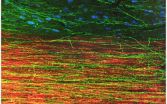(Press-News.org) DURHAM, N.C. -- In the moist, dark microbial rainforest of the intestine, hundreds of species of microorganisms interact with each other and with the cells of the host animal to get the resources they need to survive and thrive.
Though there's a lot of competition in this vibrant ecosystem, collaboration is valued too. A new study on the crosstalk between microbes and cells lining the gut of mice shows just how cooperative this environment can be.
One of the main ways that hosts manage their interactions with microbes is by carefully controlling the genes that their cells use. Duke University researchers, with colleagues from UNC-Chapel Hill and Stanford, found that the host genes in the intestine are poised to respond to microbes, and the microbes signal to the host to determine which genes respond. The study appears August 7 in the journal Genome Research.
"The intestine has a tough assignment – it has to allow for digestion and absorption of dietary nutrients while also carefully harboring and managing the teeming microbial community within," said John Rawls, an associate professor of molecular genetics and microbiology in the Duke School of Medicine.
"These physiologic responsibilities and microbial interactions vary at different places along the gut." Molecules produced on demand by the host's genes have lots of different jobs that might help or hurt the bugs: immune responses, digestive enzymes, physiological "climate control" and metabolism, among others. In some cases, the microbes might even be calling in immune system attacks on their competitors, Rawls said. "Good fences make good neighbors."
Scientists have known for some time that different genes of the host are active (or expressed) at different stretches along the length of the gut, which is about 25 feet in humans. But how those genes interact with the microbial community hasn't been clear.
Every cell contains the complete set of DNA in the human genome, but most of it is tightly spooled away in storage and unavailable for expression. Depending on the tissue type and what jobs that tissue is doing, distinct portions of DNA are unspooled to become available for activity through a structure called open chromatin, said Gregory Crawford, an associate professor of pediatrics and expert on gene expression. These open chromatin regions are known to be key locations in the genome that control which genes are expressed and which aren't.
The researchers went into this study expecting to find that the microbes signaled the host to open up areas of chromatin to activate gene expression in the gut. But what they found is that the host chooses which chromatin regions are opened to make genes available for use in each region of the intestine.
Three different mouse populations were used for the study: mice that were raised germ-free, mice that started germ-free for 8-10 weeks but then got an intensive two-week colonization with microbes, and conventionally-raised mice exposed to whatever microbes were available in their environment.
Rather than finding three different patterns of open chromatin however, the experiments found that all three were pretty much the same. Their microbial exposures varied and gene expression patterns varied, but the parts of the genome that were open at each location in the gut remained consistent, Crawford said.
"In other words, access to the genes is determined by the host, but usage of particular genes is regulated by the microbes," Crawford said.
The current study just looked at cells of the epithelium, the layer of cells lining the gut, but there would be other cells responding to these microbial signals as well. "It's likely that these microbial signals reach other cells throughout the body, which in turn mount their own specific responses," Rawls said.
Rawls said many genes that are activated by microbes in the mouse gut are similarly responsive in the fish gut. "These are presumably very ancient modes of communication between the microbes and their animal hosts," Rawls said. "Microbes shape our health profoundly, but we're only starting to understand how they do it."
Having established some understanding of the open chromatin landscape in healthy mice, the researchers now hope to figure out how these relationships change with disease states.
INFORMATION:
This research was supported by the National Institutes of Health (P30-DK034987, P40-OD010995, R01-DK081426, R01-HD059862, P01-DK094779), the National Science Foundation (DGE-1147470), the PhRMA Foundation and the Pew Scholars in the Biomedical Sciences Program.
CITATION: "Microbiota modulate transcription in the intestinal epithelium without remodeling the accessible chromatin landscape," J. Gray Camp, Christopher Frank, Colin Lickwar, Harendra Guturu, Tomas Rube, Aaron Wenger, Jenny Chen, Gill Bejerano, Gregory Crawford, John Rawls. Genome Research, Sept. 2014. DOI: 10.1101/gr.165845.113
Gut microbes browse along a gene buffet
Collaboration between the host and microbes of the gut is finely tuned
2014-08-07
ELSE PRESS RELEASES FROM THIS DATE:
NASA sees Hurricane Julio organize and emit a gamma-ray flash
2014-08-07
NASA's Fermi and Aqua satellites captured two different views of bursts of strength show by Hurricane Julio as it intensified. NASA's Fermi satellite saw a gamma-ray flash from Julio, while NASA's Aqua satellite saw Julio become more structurally organized as a hurricane.
This type of outburst is known as a terrestrial gamma-ray flash (TGF). Produced by the powerful electric fields in thunderstorms, TGFs last only a few thousandths of a second but emit gamma rays that make up the highest-energy naturally-occurring light on Earth. Scientists estimate that, on average, ...
Wild sheep show benefits of putting up with parasites
2014-08-07
In the first evidence that natural selection favors an individual's infection tolerance, researchers from Princeton University and the University of Edinburgh have found that an animal's ability to endure an internal parasite strongly influences its reproductive success. Reported in the journal PLoS Biology, the finding could provide the groundwork for boosting the resilience of humans and livestock to infection.
The researchers used 25 years of data on a population of wild sheep living on an island in northwest Scotland to assess the evolutionary importance of infection ...
NASA sees Genevieve cross international date line as a Super-Typhoon
2014-08-07
Tropical Storm Genevieve had ups and downs in the Eastern Pacific and Central Pacific over the last week but once the storm crossed the International Dateline in the Pacific, it rapidly intensified into a Super Typhoon. NASA-NOAA's Suomi NPP satellite captured of the storm.
When Suomi NPP flew over Genevieve on August 7 at 01:48 UTC the Visible Infrared Imaging Radiometer Suite (VIIRS) instrument aboard captured an infrared image of the storm. VIIRS collects visible and infrared imagery and global observations of land, atmosphere, cryosphere and oceans. VIIRS flies aboard ...
Dramatic growth of grafted stem cells in rat spinal cord injuries
2014-08-07
Building upon previous research, scientists at the University of California, San Diego School of Medicine and Veteran's Affairs San Diego Healthcare System report that neurons derived from human induced pluripotent stem cells (iPSC) and grafted into rats after a spinal cord injury produced cells with tens of thousands of axons extending virtually the entire length of the animals' central nervous system.
Writing in the August 7 early online edition of Neuron, lead scientist Paul Lu, PhD, of the UC San Diego Department of Neurosciences and colleagues said the human iPSC-derived ...
Human skin cells reprogrammed as neurons regrow in rats with spinal cord injuries
2014-08-07
While neurons normally fail to regenerate after spinal cord injuries, neurons formed from human induced pluripotent stem cells (iPSCs) that were grafted into rats with such injuries displayed remarkable growth throughout the length of the animals' central nervous system. What's more, the iPSCs were derived from skin cells taken from an 86-year-old man. The results, described in the Cell Press journal Neuron, could open up new possibilities in stimulating neuron growth in humans with spinal cord injuries
"These findings indicate that intrinsic neuronal mechanisms readily ...
Cancer study reveals powerful new system for classifying tumors
2014-08-07
Cancers are classified primarily on the basis of where in the body the disease originates, as in lung cancer or breast cancer. According to a new study, however, one in ten cancer patients would be classified differently using a new classification system based on molecular subtypes instead of the current tissue-of-origin system. This reclassification could lead to different therapeutic options for those patients, scientists reported in a paper published August 7 in Cell.
"It's only ten percent that were classified differently, but it matters a lot if you're one of those ...
Largest cancer genomic study proposes 'disruptive' new system to reclassify tumors
2014-08-07
Novato, California: Researchers with The Cancer Genome Atlas (TCGA) have analyzed more than 3500 tumors on multiple genomic technology platforms, revealing a new approach to classifying cancers. This largest-of-its-kind study, published online August 7th in Cell featured major contributions by Buck faculty Christopher Benz, MD and Senior Staff Scientist Christina Yau, PhD.
TCGA scientists analyzed the DNA, RNA and protein from 12 different tumor types using six different TCGA "platform technologies" to see how the different tumor types compare to each other. The study ...
University of Minnesota research finds key piece to cancer cell survival puzzle
2014-08-07
An international team led by Eric A. Hendrickson of the University of Minnesota and Duncan Baird of Cardiff University has solved a key mystery in cancer research: What allows some malignant cells to circumvent the normal process of cell death that occurs when chromosomes get too old to maintain themselves properly?
Researchers have long known that chromosomal defects that occur as cells repeatedly divide over time are linked to the onset of cancer. Now, Hendrickson, Baird and colleagues have identified a specific gene that human cells require in order to survive these ...
Notch developmental pathway regulates fear memory formation
2014-08-07
Nature is thrifty. The same signals that embryonic cells use to decide whether to become nerves, skin or bone come into play again when adult animals are learning whether to become afraid.
Researchers at Yerkes National Primate Research Center, Emory University, have learned that the molecule Notch, critical in many processes during embryonic development, is also involved in fear memory formation. Understanding fear memory formation is critical to developing more effective treatments and preventions for anxiety disorders such as post-traumatic stress disorder (PTSD).
The ...
Scientists uncover stem cell behavior of human bowel for the first time
2014-08-07
For the first time, scientists have uncovered new information on how stem cells in the human bowel behave, revealing vital clues about the earliest stages in bowel cancer development and how we may begin to prevent it.
The study, led by Queen May University of London (QMUL) and published today in the journal Cell Reports, discovered how many stem cells exist within the human bowel and how they behave and evolve over time. It was revealed that within a healthy bowel, stem cells are in constant competition with each other for survival and only a certain number of stem ...
LAST 30 PRESS RELEASES:
Tracing the quick synthesis of an industrially important catalyst
New software sheds light on cancer’s hidden genetic networks
UT Health San Antonio awarded $3 million in CPRIT grants to bolster cancer research and prevention efforts in South Texas
Third symposium spotlights global challenge of new contaminants in China’s fight against pollution
From straw to soil harmony: International team reveals how biochar supercharges carbon-smart farming
Myeloma: How AI is redrawing the map of cancer care
Manhattan E. Charurat, Ph.D., MHS invested as the Homer and Martha Gudelsky Distinguished Professor in Medicine at the University of Maryland School of Medicine
Insilico Medicine’s Pharma.AI Q4 Winter Launch Recap: Revolutionizing drug discovery with cutting-edge AI innovations, accelerating the path to pharmaceutical superintelligence
Nanoplastics have diet-dependent impacts on digestive system health
Brain neuron death occurs throughout life and increases with age, a natural human protein drug may halt neuron death in Alzheimer’s disease
SPIE and CLP announce the recipients of the 2025 Advanced Photonics Young Innovator Award
Lessons from the Caldor Fire’s Christmas Valley ‘Miracle’
Ant societies rose by trading individual protection for collective power
Research reveals how ancient viral DNA shapes early embryonic development
A molecular gatekeeper that controls protein synthesis
New ‘cloaking device’ concept to shield sensitive tech from magnetic fields
Researchers show impact of mountain building and climate change on alpine biodiversity
Study models the transition from Neanderthals to modern humans in Europe
University of Phoenix College of Doctoral Studies releases white paper on AI-driven skilling to reduce burnout and restore worker autonomy
AIs fail at the game of visual “telephone”
The levers for a sustainable food system
Potential changes in US homelessness by ending federal support for housing first programs
Vulnerability of large language models to prompt injection when providing medical advice
Researchers develop new system for high-energy-density, long-life, multi-electron transfer bromine-based flow batteries
Ending federal support for housing first programs could increase U.S. homelessness by 5% in one year, new JAMA study finds
New research uncovers molecular ‘safety switch’ shielding cancers from immune attack
Bacteria resisting viral infection can still sink carbon to ocean floor
Younger biological age may increase depression risk in older women during COVID-19
Bharat Innovates 2026 National Basecamp Showcases India’s Most Promising Deep-Tech Ventures
Here’s what determines whether your income level rises or falls
[Press-News.org] Gut microbes browse along a gene buffetCollaboration between the host and microbes of the gut is finely tuned



